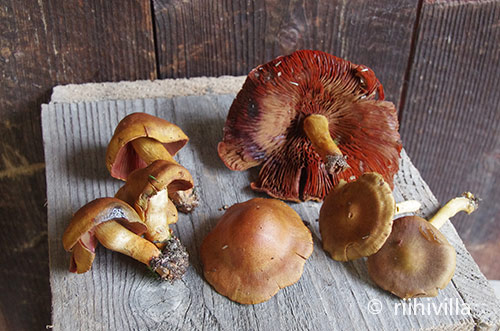Seuraava sienivärjäys kuivatuilla sienillä oli hurmeseitikeillä (Cortinarius purpureus, syn Cortinarius phoeniceus).
Hurmeseitikki on hyvin samanoloinen sieni kuin verihelttaseitikkikin, mutta hiukan harvinaisempi. Se kasvaa rehevissä havumetsissä, rehevimmillä paikoilla nähtävästi kuin verihelttaseitikki, ja mm nämä sienet kasvoivat vanhan muurahaispesän ympärillä, minne oli kertynyt paksu kerros havuneulaskariketta.
IN ENGLISH
Next I dyed with dried Cortinarius purpureus (syn. Cortinarius phoeniceus).
It is very similar looking webcap as more common Cortinarius semisanguineus, and grows here in rich spruce forests. Apparently it craves more rich soil than C.semisanguineus, and the mushrooms in these pictures were growing around an old and big anthill, where there was a thick layer of needles on the ground.
Hurmeseitikki on yleensä isokokoinen, paksumaltoinen ja tukevamman oloinen kuin verihelttaseitikki. Vaikutelma tulee siitä, että sen jalka on paksumpi ja lyhyempi suhteessa lakkiin kuin verihelttaseitikin jalka. Yllä ja alapuolella olevissa kuvissa oikeassa reunassa on vertailuksi kaksi verihelttaseitikkiä ja erot jaloissa näkyvät selvästi. Myös lakin värityksessä on usein eroa. Tärkein ero on kuitenkin yleishabituksen lisäksi jalassa: verihelttaseitikin jalka on vaalean keltainen, sillä on vain jalan tyvessä punaista, kun taas hurmeseitikin koko jalassa on punaista häivemäistä seittiä, mikä tekee jalasta punertavamman näköisen.
Näiden sienten kanssa erot ovat suhteellisia, ja ennenkuin on löytänyt hurmeseitikkiä, sitä katsoo jokaista seitikkiä, että onkohan tämä nyt se, mutta kun sitten löytää oikean hurmeseitikin, niin kyllä sen heti erottaa verihelttaseitikeistä, ja sen jälkeen erottaminen on helpompaa:).
IN ENGLISH
Cortinarius purpureus is usually big webcap, and it has thick flesh and looks sturdier than C.semisanguineus. Sturdy impression comes from shorter and thicker stem in C.purpureus compared to the stem of C.semisanguineus. In the pictures above and below there are two C.semisanguineus on the right , and you can see the difference in the stems. Also the color of the cap may be different. The most important difference, added to the over all habitus, is the stem. C.semisanguineus stem is slim, pale yellow with red velum only at the base of the stem, while C.purpureus has web-like red on the whole stem, which gives it redder impression.
These differences are relative, so they are difficult when you haven't yet found both of these mushroom, but when you find C.purpureus for the first time, you can immediately see, that it is something else than C.semisanguineus:).
Hurmeseitikin väriaineet ovat pääasiassa punaisia, dermocybiiniä ja sen glukosideja, ja siksi sillä värjätessä jälkiväristä ei tulekaan sellaista oranssia tai keltaista kuin muilla tavallisilla seitikeillä tai veriseitikillä. Toisaalta Lundmarkin kirja sanoo, että erityisesti hurmeseitikin jälkiväreillä valonkesto on huonompi kuin muiden seitikkien väreillä. Tästä syystä käytinkin nyt aika paljon sieniä suhteessa lankaan eli 100g kuivattuja sieniä sataa grammaa lankaa kohti. Sieniä oli liotettu yön yli, haudutettu tunti ja sitten lisäsin jäähtyneeseen väriliemeen alunalla ja viinikivellä esipuretetut langat. Sienet olivat samassa liemessä koko värjäyksen ajan, ja tästä syystä väristä tuli hiukan epätasaista, mutta varsinkin ensimmäinen karmiininpunainen on ihan hieno väri. Nyt vaan pitää sitten odottaa taas uutta hyvää seitikkivuotta.
IN ENGLISH
The dyestuffs in Cortinarius purpureus are mainly reds, dermocybin and it's glucosides, and that is why the after bath of C.purpureus from less orange or yellow than when dyeing with other webcaps. On the other hand Swedish Lundmarks's book says that particularly the after baths from this mushroom are not as lightfast as the after baths from other Cortinarius mushrooms.
That is why I used now a lot of mushrooms: 100g of dried C.purpureus to 100grams of yarn. I soaked the mushroom over night, then simmered for one hour, and after cooling the bath, added the mordanted fiber. The mushrooms were in the same bath with the fiber during the dyeing, and this is why the color is slightly uneven (the parts of the fiber which touched the mushrooms got more color), but I think the darker color from the first bath is really nice. Now I have to wait for the next good mushroom autumn to get more of these.


















